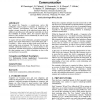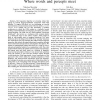262 search results - page 5 / 53 » Meetings and meeting modeling in smart environments |
ICMI
2005
Springer
14 years 1 months ago
2005
Springer
We present the Connector, a context-aware service that intelligently connects people. It maintains an awareness of its users' activities, preoccupations and social relationsh...
ICMI
2007
Springer
14 years 1 months ago
2007
Springer
In this paper, an influence model is used to recognize functional roles played during meetings. Previous works on the same corpus demonstrated a high recognition accuracy using SV...
IROS
2006
IEEE
14 years 1 months ago
2006
IEEE
— Our long-term objective is to develop robots that engage in natural language-mediated cooperative tasks with humans. To support this goal, we are developing an amodal represent...
CORR
2010
Springer
13 years 7 months ago
2010
Springer
Two mobile agents (robots) with distinct labels have to meet in an arbitrary, possibly infinite, unknown connected graph or in an unknown connected terrain in the plane. Agents ar...
ATAL
2010
Springer
13 years 8 months ago
2010
Springer
Ant robots have very low computational power and limited memory. They communicate by leaving pheromones in the environment. In order to create a cooperative intelligent behavior, ...



